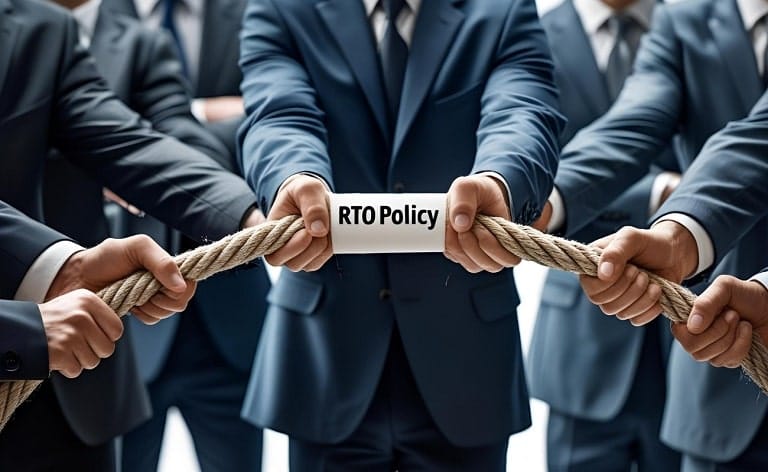Introduction: A Silent Standoff in the C-Suite
In the wake of a post-pandemic world, the debate over remote, hybrid, and in-office work has shifted from employees to the executive suite. Many companies now face a quiet but significant challenge: navigating executive disagreements on RTO policy.
While some senior leaders champion the benefits of physical presence—serendipitous collaboration, stronger culture, increased visibility—others argue that flexibility and productivity do not depend on proximity. The result? Strategic drift, fractured messaging, and stalled progress on a consistent work model for leadership.
At JRG Partners, we’ve seen this scenario unfold across industries—and the implications go far beyond where the CEO sits on Monday morning.
Pro Tip: Resolving such strategic divisions often requires a new leader with strong change management skills, a key profile our C-suite recruiting team excels at finding.
1. The Roots of Division: Philosophical and Practical Tensions
When the leadership team is divided on the return-to-office policy for executives, it’s often not just about logistics. It’s about deeper, sometimes unspoken, views on leadership, control, performance, and trust.
- Some executives believe leadership should be visible to be effective.
- Others prioritize results over presence, citing global teams and digital tools.
- There are fears of “optics” from being remote, even if performance is high.
- Cultural concerns clash with individual preferences and lifestyle shifts.
The challenge is not only aligning C-suite on hybrid work strategy, but doing so in a way that doesn’t create resentment, attrition, or brand inconsistency.
2. The Cost: Impact of RTO Policy on Executive Retention
Inconsistent return-to-office expectations can lead to more than grumbling. They can cause:
- Executive churn: Top leaders who feel untrusted or constrained will quietly explore other options.
- Leadership misalignment: Disagreements spill into decision-making processes, causing confusion or paralysis.
- Employee cynicism: If different rules apply to different levels, it undermines broader RTO messaging.
- Succession risk: Rising leaders may reconsider long-term commitments if flexibility isn’t modeled at the top.
Ultimately, the impact of RTO policy on executive retention is real—and measurable.
3. Leadership Communication for Return to Office

When policies are fragmented, communication becomes the antidote—or the accelerant to the problem.
Strong leadership communication for return to office includes:
- Unified messaging: Even if compromise is needed, the final policy must be communicated as a collective decision.
- Transparent rationale: Explain the “why” behind the decision—be it productivity, culture, client need, or talent strategy.
- Bidirectional dialogue: Invite feedback and questions from other senior leaders to maintain trust.
- Consistency across levels: The C-suite must model whatever expectations are being asked of the broader workforce.
At JRG Partners, we recommend structured alignment sessions that allow execs to surface concerns, challenge assumptions, and pressure-test scenarios—before taking the debate public.
4. Executive Assessment for Flexible Work Leadership
Sometimes, a return-to-office divide reveals something deeper: a clash of leadership philosophies.
We help boards and investors conduct executive assessment for flexible work leadership, evaluating how well each leader:
- Navigates ambiguity and change.
- Builds culture in hybrid or remote models.
- Balances empathy with accountability.
- Operates with high visibility, even from afar.
Some leaders thrive in a command-and-control, in-person setup. Others lead through influence, digital tools, and trust. Knowing the composition of your leadership styles is essential to designing an RTO policy that works—and sticks.
5. Aligning C-Suite on Hybrid Work Strategy
To resolve a divided RTO policy, the goal isn’t necessarily consensus—it’s alignment.
Here’s how to get there:
- Clarify principles before rules: Are you optimizing for collaboration, equity, productivity, innovation, or retention?
- Use data: What does your executive performance data show pre- and post-remote work?
- Run pilot programs: Test flexible models for senior leadership and analyze the results before scaling.
- Bring in a neutral facilitator: External consultants or board members can help navigate the politics and surface underlying tensions.
Most importantly, communicate that the policy isn’t a judgment on any individual—it’s a strategic decision to position the company for success.
This division on policy often reflects a deeper misalignment in leadership, which is why it’s so important to know how to assess a CEO’s ability to build and lead a fully remote culture.
Conclusion: Resolve the Disagreement, Protect the Culture
A fractured C-suite on return-to-office signals a moment of inflection. The challenge isn’t just about geography—it’s about trust, alignment, and the kind of culture your leadership is modeling.
At JRG Partners, we guide companies through these high-stakes executive transitions. Whether you’re revisiting your hybrid strategy, assessing leadership readiness for flexible work, or mediating C-suite disagreements, we can help you align policy with purpose—and keep your top talent on board.
Remote, hybrid, or in-person—it’s not just where they work. It’s how they lead. To explore how JRG Partners can support your leadership alignment and return-to-office strategy, get in touch with our team today.


